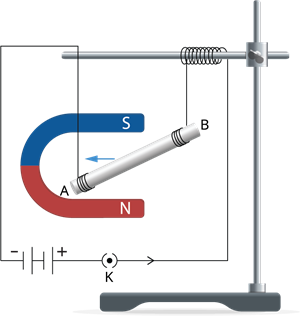
PUMPA - SMART LEARNING
எங்கள் ஆசிரியர்களுடன் 1-ஆன்-1 ஆலோசனை நேரத்தைப் பெறுங்கள். டாப்பர் ஆவதற்கு நாங்கள் பயிற்சி அளிப்போம்
Book Free DemoDescribe the activity that shows that a current-carrying conductor experiences a force perpendicular to its length and the external magnetic field. How does Fleming’s left-hand rule help us to find the direction of the force acting on the current carrying conductor
The following activity demonstrates the force due to a magnetic field acting on a current-carrying conductor.
Steps:
- Take a small aluminium rod of about \(5\ cm\) and name its ends as A and B. Using two connecting wires, hang it horizontally from a stand, as shown in the below figure.

A current-carrying rod
- Locate a strong horseshoe magnet so that the rod rests between the two poles with the magnetic field directed upwards. For this, put the magnet's north pole vertically below and the south pole vertically above the aluminium rod (as shown in the figure).
- The aluminium rod, battery, key and rheostat are connected in series (as shown in the figure).
- Now allow a current flow through the aluminium rod from end B to end A
Observation:
It is seen that the rod is . You will see that the rod gets relocated.
On reversing the direction of current flowing through the rod (end A to B) and the rod is now .
The displacement of the aluminium rod suggests that a when it is placed in a magnetic field. It also shows that when the direction of the current through the conductor is reversed, the direction of force is .
According to the Flemings left-hand rule, if we arrange our thumb, forefinger and the middle finger of the , then the thumb points towards the direction of the , the middle finger the direction of and the forefinger the direction of .